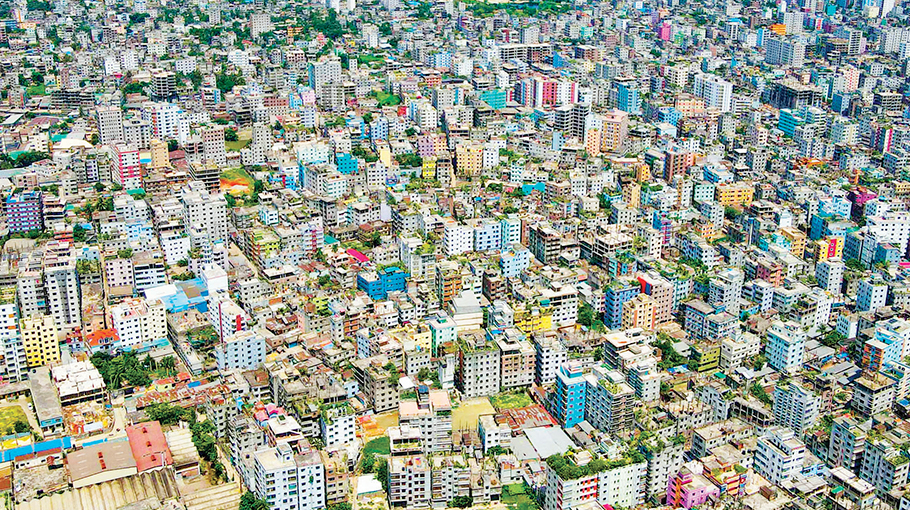Buildings rise at will!
Proper monitoring absent

Reckless developer companies are constructing illegal multi-storied buildings of 10-12 stories or more along the narrow roads in various areas of the capital Dhaka in connivance with some corrupt officials and brokers of the Capital Development Authority (RAJUK).
Despite the increase in the number of vulnerable buildings and their potential threat, Rajuk has turned a blind eye to the situation. Dhaka has already been identified by several national and international research organizations as one of the most vulnerable cities to high-magnitude earthquakes – a natural disaster that would normally turn vulnerable structures into rubble in the blink of an eye.
The risk of accidents and loss of life is increasing due to the construction of arbitrary buildings. Many buildings are collapsing while under construction or some buildings are collapsing soon after construction. Most of the buildings in Dhaka have not been constructed in line with the building code, says city development authority RAJUK.
The approval of any building construction depends on the street. According to the Bangladesh National Building Codes, any building of or exceeding 33 metres in height is considered a high-rise.
The new building code will apply to the construction of buildings all over the country. As per the existing DAP(Detailed Area Plan), in planned residential areas like Uttara,
Mirpur, Dhanmondi, Bashundhara and Banshri where the minimum road width is 25 feet; there, a 9-storey building can be constructed on a plot of 5 khata area.
In the revised DAP, the height of the building has been increased to 10 floors. And if the road is 60 feet, in that case the land owner will get design approval up to 12 floors.
The Capital Development Authority (RAJUK) revealed that 207 of Dhaka's 1,818 high-rises were not approved and 475 had no documents to show. And of the 1,136 buildings approved, their construction violated the original design. Additional floors have been constructed in 277 buildings. Many other violations were reported in 674 cases.
In line with these violations, there are 124 buildings rented out for residential use despite having only commercial permissions. And in 49 buildings, the inspection team saw commercial activities despite being residential complexes. To top it off, 309 buildings repurposed their parking space.
Such as, according to a Rajuk official, the FR Tower’s neighbouring Ahmed Tower stands 27 storeys tall despite having a 23-storey permission. Rajuk found the four additional storeys had a dedicated lift shaft cut off from the rest of the buildings as well.
The nearby Safura Tower also constructed two additional floors on top of its approved 14 storeys. Ataturk Tower was permitted to use three lower floors as commercial space and the top 10 floors as residential. But it has been using eight floors for commercial purposes.
According to the updated code, a 10-storey building or a building with a height of at least 33 meters will fall under the category of multi-storey building. In the previous building code, a five-storey building or one with a height of more than 20 meters was called a multi-storey building.
To solve this problem and to determine the height of the residential building according to the character and civic services of each area, the height of the building has been determined in the new DAP, officials of Rajuk said.
RAJUK authorities said, “Recent surveys showed that 70 to 80 percent of buildings do not comply with the building code. The list was supposed to be published within a month but it did not appear.
The new building code is going to start in the construction of buildings across the country. As per existing DAP in planned residential areas like Uttara, Mirpur, Dhanmondi, Bashundhara and Banashree where the minimum road width is 25 feet; A 9-story building can be built on 5 acres of land there. The height of the building has been increased to 10 floors in the revised DAP. And if the road is 60 feet, then the land owner will get design approval up to 12 floors.
According to the building code, Capital Development Authority (RAJUK) has given concessions in three categories in the revised DAP. The categories are planned residential areas, unplanned residential areas and block-based development. The Ministry of Housing and Public Works has issued a notification with some amendments to the Detailed Area Plan or DAP.
After reviewing the new DAP, it was found that the 1,528 square kilometer area included in Rajuk has been divided into a total of 468 (blocks). Later, the survey determined the height of residential buildings based on population capacity, road infrastructure, civic amenities and type of development in each block. Blocks with better civic amenities and drainage network, more open space, and higher building heights are considered.
As such, 6 floors in Khilkhet, Kuril, Nikunj area of Dhaka North City Corporation; 7-8 floors in Uttara; Gulshan, Banani, Baridhara area 6-8 floors; 4-7 floors in Mirpur area; 5-8 storey residential buildings can be constructed in Mohammadpur-Lalmatia area. On the other hand, 4-6 storey residential buildings can be constructed in old Dhaka under Dhaka South City Corporation. Except two areas in Gazipur, the maximum height of residential buildings in most areas will be 4-6 floors.
The authorised officers of all the eight zones have already been asked to issue notices on the owners of the illegally developed high-rises as identified by Rajuk’s vigilance team, the agency’s development control director Begum Tanjila Khanam said earlier.
Rajuk vigilance team in its jurisdiction areas in April identified 475 high-rises, including 44 government buildings, built without any approval from Rajuk or any other agencies such as department of architecture, city corporations or cantonment board.
These 44 high rises were developed by the Public Works Department, Dhaka University, Bangladesh University of Engineering and Technology at different areas such as Mirpur, Ramna and Plassey mostly as residential buildings for officials, employees and teachers.
Rajuk teams found that 309 high-rises were vertically expanded without permission and 738 buildings violated land use norms 5.5 feet.It found that 1,155 high-rises lacked sufficient firefighting equipment such as hydrant, extinguishers, hose and alarm system.
An alarming lack of firefighting equipment was also noted in 1,155 buildings, and 566 have no emergency exit. There are 721 buildings that had the fire exit made elsewhere, violating the approved designs.
It is also noted that as per a survey report by the Department of Fire Service and Civil Defence, it is seriously alarming that about 38.87 percent of high-rises are vulnerable to fire.In 2022, the fire service department inspected 5,869 public and privately owned buildings and found 2,223 of them at risk and at least 617 buildings were marked to be at high fire risks.
In the period, 24,102 fires took place across the country that left 98 people, including 13 firefighters, dead and the estimated material loss was worth Tk 342 crore.




